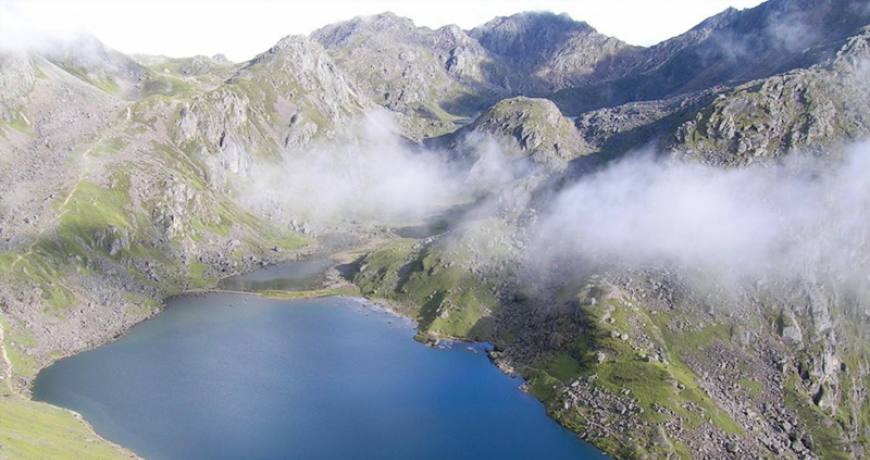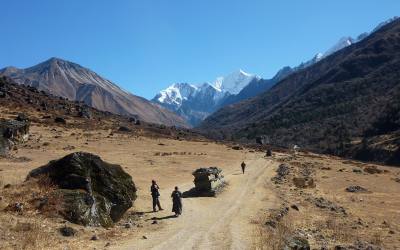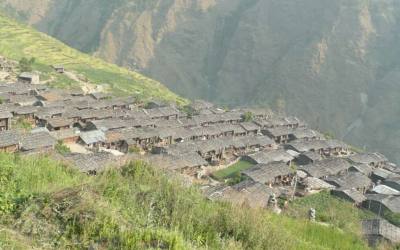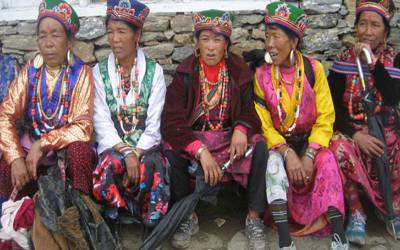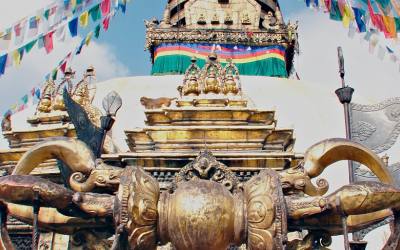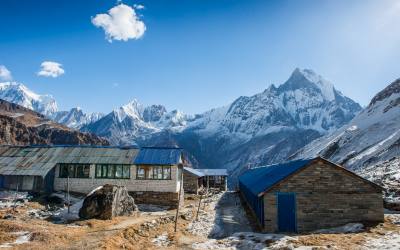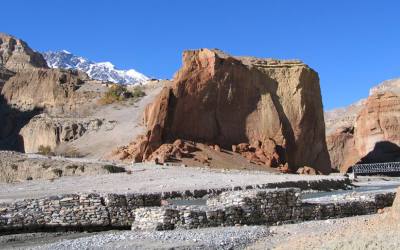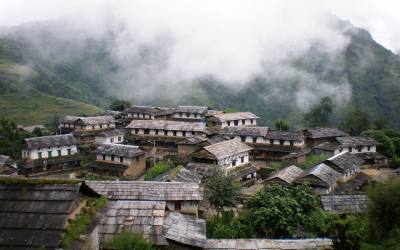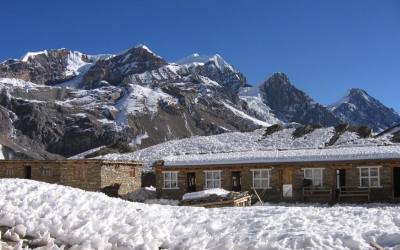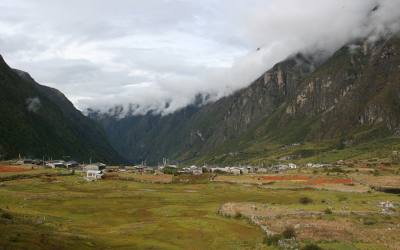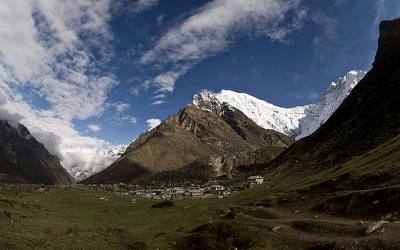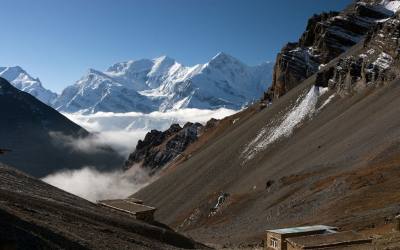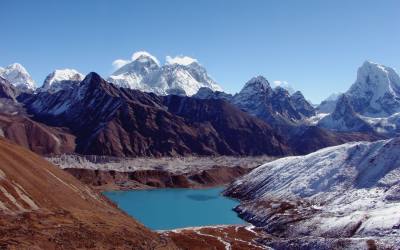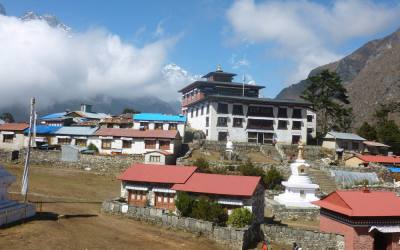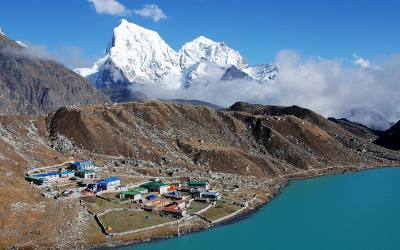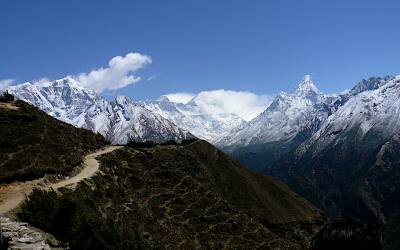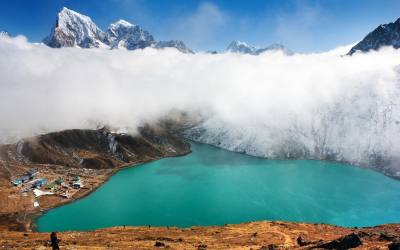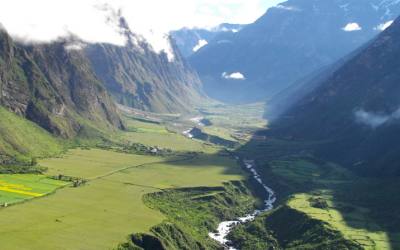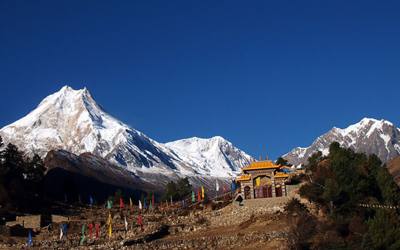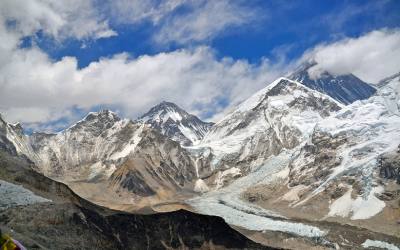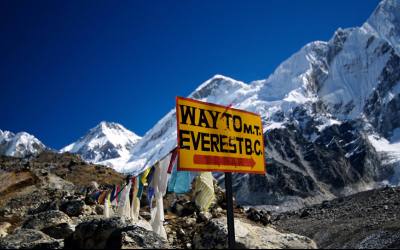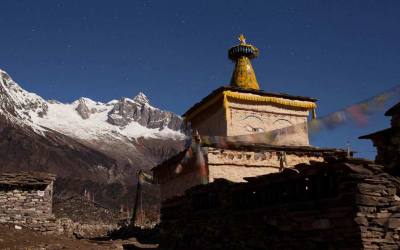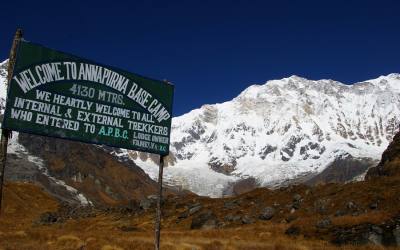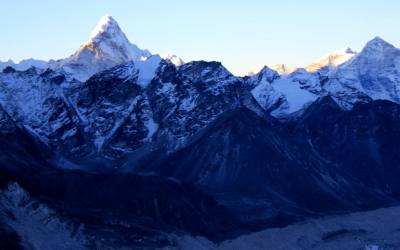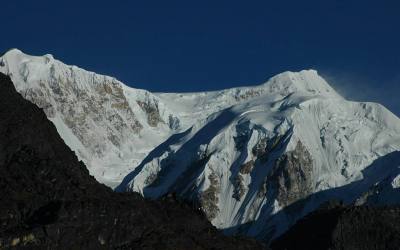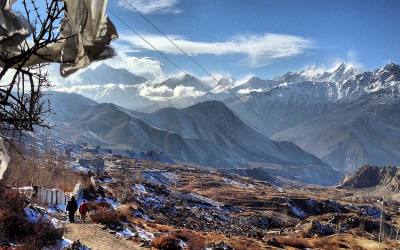The Langtang Himal is a region north part of Kathmandu. valley and it lies just south of Tibetan border. Langtang / GosaikundaThe langtang valley is sourrounded by high peaks of great appeal. It has become famous ever since the British mountaineer Bill Tilman described it as the most beautiful valley in the world. The highest peak in this area is Shisapangma or Gosaithan 8027m in Tibet. The course from the Langtang valley to Gosaikund is full of diversity and it is attracting many tourists. The langtang valley is also know as the treasure house of Alpine plants. The whole valley is cover with flowers during the summer.
This high and isolated region is inhabited by Tamangs whose religious practices, language and dress are much more similar to Tibetan.
Gosaikunda
is one of the hindu holy place and is considered to be made by Lord Shiva. The Buddhist Tamang that live nearby also revere it as their holy place. Every August on full moon nights lake is thronged with pilgrims for a big festival. On other days the lake sits in a tranquil atmosphere.
Flora and Fauna
The forests of Helambhu region and Langtang area prime example of temperate and sub alpine vegetation. The dense oak and pine forests on the trail of particular interest. As usual , the rhododendrons from a spectacular display during the spring.
People and culture
The people here, are of Tibetan origin and call themselves sherpa although they are quite distinct from the sherpas of Everest region both in language and customs. Many Tamang people also inhabit this area, Tamangs are also orginated in Tibet but settled in Nepal considerably earlier than Sherpas.
Day 01: Arrival and transfer to hotel in Kathmandu
Day 02: Bus local bus to Syaprubesi(1650m) or by private jeep. The private jeep will cost extra. 8 hrs of driving
Day 03: Syaprubesi to Lama hotel(2400m) 6-7 hrs of trek
Day 04: Lama hotel to Langtang valley (3307m) 6 hrs of trek
Day 05: Langtang to Khayanjing gompa(3800m) at the afternoon climbing to Khanjingri (4200m) 4 hrs of trek
Day 06: Khayanjing Gompa rest day or side trip to Tsercori peak (5033m) 6-7 hrs of Trek.
Day 07: Side trip to Langsisha kharka (4100m) and Return back to Khanjing Gompa. 7-8 hrs of trek.
Day 08: Khayanjing Gompa to Lama hotel(2500m) 6 hrs of trek
Day 09: Lama hotel to Thulo Syabru(2200m) 6 hrs of trek
Day 10: Thulo Syabru to Sing gompa or to Cholangpati (3300m Buddhist Monastery) 5 hrs of trek
Day 11: Sing Gompa to Gosaikund Lake(4260m) 4 hrs of trek
Day 12: Gosaikund to Dhunche 1850m. 6 hrs of trek
Day 13: Dhunche to Kathmandu by local bus. the bus journey will take 8-9 hours.
Day 14: Free day in Kathmandu or self visiting around the valley.
Day 15 Tour Ends ( Departure)
Day 01: Arrival and transfer to Hotel in Kathmandu.
Upon arrival in Kathmandu. Our airport representative will be waiting outside the airport terminal a few metres from the exit door. Please check your name at play card. He will bring you to hotel in kathmandu. The drive from the airport to the hotel is around 20 minutes. if you have time then you can self visit to Kathmandu durbar square.
Hanumandhoka (Kathamdnu Durbar Square):
It is the historic seat of royalty. The Durbar Square, with its old temples and palaces, epitomizes the religious and cultural life of people. It is here that kings of Nepal are crowned and their coronations solemnized. Interesting things to see here are, Taleju temple built by king Mahendra Malla in 1954 AD, the temple of Kal Bhairab , the god of destruction, Nautale durbar, the statue of King Pratap Malla, the big drum and the Jaganath temple. It was listed in the UNESCO world heritage monument list in 1979.
On the right hand corner, a large wooden lattice screen hides an enormous gilded face of Sweta Bhairab. The screen is removed only during the Indra Jatra festival.. there are also the Numismatic museum and Tribhuban museum inside the Hanuman Dhoka palace building . Photography is prohibited inside the museums. Both the mseums remain closed on Tuesday and government holidays.
Day 02: Local Bus ride to Syaprubesi the bus journey will take 8 to 9 hrs. Dhunche is the center of this area and has public offices and army camp.
You are heading north out of Kathmandu driving through scenic foothills and ridgeline vistas to Dhunche or Syaprubesi. While passing along the road on the bank of the Trishuli River you catch a glimpse of Ganesh Himal, terraces and green hills
Day 03: Syaprubesi to Lama Hotel ( 2400 m)
It takes about five and half hours. The first part of the trail crosses through Bhote Koshi and follows the Langtang Khola. This trail is gradually ascent up to Bamboo passing through Landslide. Afterwards, you trek ascends gently to Rimche (2400m.) through Bamboo (1960m.) which lies at the bank of Langtang Khola. You can have lunch at this place if you like. And at the end your trail is level to the Lama Hotel. En route you could see red pandas, monkey and bear if you are lucky.
Day 04: Lama hotel to Langtang valley (3307m)
After Lama hotel you will climb through a Rhododendron forest . the ground covered by moss. Trees have ferns and epiphytic orchids on them. It looks like semi tropical jungle.
As you continue climbing there are occasional glimpses of Langtang Lirung between the trees. At Ghora Tabela [3000m], the trail emerges from the forest. Once there was a Tibetan resettlement project here, but now it is a Nepalese army post though it has no permanent inhabitants. The trail continues to climb gently and the valley widens, passing a few temporary settlements used by herders who bring their livestock to graze in the high pastures during the summer months. There is a monastery, which you can visit shortly before arriving at the village of Langtang, the headquarters of the Langtang National Park. The houses of Langtang and its neighboring villages are of the flat-roofed Tibetan style, surrounded by stone walls enclosing fields of buckwheat, potatoes, wheat, turnips and barley
Day 05: Langtang to Khayanjing gompa(3800m) and at the afternoon visiting to Khanjingri.
The trail climbs gradually through small villages and yak pastures as the valley opens out further and the views become more extensive. After crossing several small streams and moraines, the trail reaches the settlement at Kyangjin. Here, there is a small monastery and a government-operated cheese factory. You should arrive at Kyangjin by lunch time allowing time to acclimatize and explore the area. It is a dramatic setting, with snow-covered peaks surrounding you in all directions such as Langtang Lirung, Ganjala peak, Tserko- Ri, Langsisa ri and many others.
Day 06: Khayanjing Gompa rest day or climb to Tsercori peak (5033m)
Khayanjing Gompa is the last permanent settlement with a small Gompa and a cheese factory. Use it as a base for day hikes, exploring the upper valley try to climbing the small hill north of Khayanjing or Tsergori(5033m). which lies upvalley from Khayanjing. Upper valley is ringed by spectacular snow peaks including fluted peak Langtang Lirung and the Tibetan named Dorje Lakpa .
Day07: Side trip to Langsisha kharka (4100m) and return back to Khanjing Gompa.
This is a good long walk that takes you all the way up the valley to where the Salbachum, Lanshisha Kharka, and Langtang glacial moraines all converge. To get there you just continue on the trail heading east out of Kyanjin Gompa. You'll follow the valley past the turn off to Tsergo Ri and past the air field. During the walk you only gain about one thousand feet over five or so miles. Round trip this can take the better part of a day so it's best to pack some lunch and bring some water with you,
Along the way you get some great views of the nearby peaks including Dorje Lakpa, and eventually Shisha Pangma, the only 8,000 meter peak in Tibet. During summer and early fall many yaks are still up in the high pastures.
Day 08: Khayanjing Gompa to Lama hotel(2400m)
From Kyangjin you retrace your route, following the Langtang Khola to Langtang village and on to Ghora Tabela. After lunch, you continue the steep descent to Lama Hotel.
Day 09: Lama hotel to Thulo Syabru(2200m)
You continue retracing your steps some of the way to Thulo Syabru, but then branch left ascending a steep path through forests to suddenly emerge with a view of Syabru and its extensive area of millet terraces. An undulating path brings you to this fascinating village where each house is set above its neighbor, in a long line up the very crest of the ridge. It’s a great place to wander about, catching glimpses of Tamang life, admiring the beautifully carved wooden windows or simply relaxing in the sun.
Day 10: Syabru to Sing gompa (3300m) Buddhist Monastery
From Thulo Syabru it is a steep climb through forests of oak, fir and rhododendron to the top of a ridge. From here it is only a short descent to Sing Gompa. There is a Buddhist monastery and a small cheese factory.
Day 11: Sing Gompa to Gosaikund Lake(4260m)
From here the path gently ascends the mountain flank with bare trees. After crossing the ridge . you will be going through a forest full of moss and fern. While you reach to Lauribinayak there is a spectacular views of Dhaulagiri, Annapurna, Ganesh Himal and Langtang Lirung. The best view point for entire trek. Crossing over the ridge of Saraswati Kund apper the first of several Lakes dedicated to different divinities. Gosaikund is the third lake, sacred place of Hindus and Buddhist.
Day 12: Gosaikund to Dhunche (1850m)
You trek downhill all the way to Ghatte Khola (stream) passing forests, a small village Dimsa and terraces. Now you will trek over a leveled path along Ghatte Khola (stream) till Dhunche.
Day 13: Dhunche to Kathmandu by local bus or by private jeep. the bus journey will take 8 to 9 hours.
Day 14: Free day in Kathmandu or self visiting around the valley. ( The option are)
Swoyambhunath (Monkey Temple)
This is one of the world‘s most glorious Buddhist Chaityas. It is said to be 2,000 years old. Painted on the four sides of the spire’s base are the all seeing eyes of Lord Budhha. It is 3Km west of Kathmandu city and it situated on a hillock about 77 m commands an excellent view of the Valley. This stupa is the oldest of its kind in Nepal. It was listed in the UNSCO world Heritage Monument List in 1979
Bouddhanath Stupa
Bouddhanath Stupa, the biggest stupa in Nepal, lies about 7 km east of the capital. The Bouddhanath stupa, also called by many as Khasti Chitya, is one of the oldest stupas in the country. After 1959, many Tibetans arrived and settled in Bouddhanath area. The stupa, a well-known Buddhist pilgrimage site, is included in World Heritage Cultural site list by UNESCO
Pashupatinath Temple:
Situated 5km east of kathamandu, the temple of Lord Shiva, Pashupatinath, with two tired golden roof and silver door is considered one of the holiest for Hindus. Although only Hindus are allowed inside the temple, visitors can clearly see the temple and the activites performed in the Temple premises from the eastern bank of the Bagmati river. The Temple was listed in the UNESCO world heritage Monument List in 1979
Patan
The ancient city of Patan, lying 5 km southwest of kathmandu, is known as the city of fine arts, The city is full of Hindu temples and Buddhist monuments. The diversity of the medieval culture that allowed both Hinduism and Buddhism to flourish has left a rich legacy of impressive sightseeing in this city for today’s visitors.
Patan Durbar Square:
Situated in the heart of the city, constitutes the focus of visitor’s attraction. The square is full of ancient palaces, Temple and shrines, noted for their exquisite carvings. The Patan durbar Square consist of three main chowks or countryards, the Central Mul Chowk, Sundari Chowk and Keshar narayan Chowk, The Sundari Chowk holds in its center a masterpiece of stone architecture. The Royal Bath called Tushahity. It was listed in the UNESCO world Heritage Monument list in 1979.
Krishna Mandir:
Built in 1637 AD, the temple of Lord Krishaa holds a commanding position in the palace complex of Patan. It is supposed to be the first specimen of Shikhara style architecture in Nepal. It is the only temple in Nepal having 21 spires and is completely 21 spires and is completely mad of stone
Bhaktapur is "the city of Devotees". It is locally known as "Khwopa and Bhadgaon" which is world renowned for its elegant art, fabulous culture , colourful festivals, traditional dances and indigenouslifestyle of different people of different religion. For its majestic monuments, temples and the native typical newar lifestyle best known for their long history of craftsmanship, the ancient city is also variously known as the " City of Culture ", "Living Heritage " , "Nepal’s Cultural Gem " and "An open museum". Given such unequaled opulence in ancient art and culture, Bhaktapur is more like an open museum, and the ambiance here is such that it instantly transports visitors back by centuries. This conch shaped hostoric city is spreading over an area of 6.88 square KM at 1,401 meters above sea level, which was founded in the 12th century by King Anand Dev Malla.Bhaktapur was the capital city of the Greater Malla Kingdom till the 15th century AD. The many of Bhaktapur’s greatest monuments were built by thethen Malla rulers.
The ancient ritual dances and festivals are still observed by the locals with the same fervour and ehthusiasm as their ancestors did centuries ago. King Yaksha Malla (15th ventury) heavily fortified this city. Bhaktapur has its gem in Durbar Square and Changu Narayan temple-- a World Heritage site listed by the UNESCO. Strewn with unique palaces, temples and monasteries best admired for their exquisite artworks in wood, metal and stone, the palatial enclave has bewitched pilgrims and travelers for centuries.Yet, they are not all though. Stretching all along the township, the panoramic Himalaya levitates in the skyline as if to keep vigilance on the city’senviable beauty and splendor.It grows from a collection of villages strung along the old trade
Day 15: Tour Ends ( Departure )
Price Per Person US$ 475.00 (Price are based on standard class hotel)
Price for meals and drinks during the trek Allow US$ 22-24 per person per day for trekking (off-course you are going to pay every day directly by yourself to the tea houses during the trek.it is just a guideline)
Single supplement US$ 150.00 per person ( you will get single room in kathmandu and during the trek. you can book your trekking tour as a solo with us. in this case we will charge little higher)
Additional night in kathmandu will cost US$ 35.00 for Double room with Bed and Breakfast and US$ 30.00 for single room.
Trekking prices with out hotel in kathmandu will cost US$ 400.00 per person.
Off-course it is always possible to upgrade the hotel in kathmandu according to your budget and interest. But it will cost you extra and you need to pay the differences.
Hotel we use in this tour
Kathmandu Prince Hotel (standard class hotel)
Website : www.kathmanduprincehotel.com
Or
Potala Guest House (Standard class hotel)
Website : www.potalaguesthouse.com
Or
Hotel Marsyandi Mandala (Standard class hotel)
http://www.marsyangdimandala.com
Delux class hotel
Hotel Manasulu (3star)
Website: www.hotelmanaslu.com
Grand Hotel Kathmandu (4star)
Email: [email protected]
http://www.grandhotelnepal.com
Hotel Manang Pvt. Ltd (3star)
Thamel, Kathmandu, Nepal
http://www.hotelmanang.com
Hotel Yellow pagoda (4 star)
Kantipath, Kathmandu, Nepal
[email protected]
www.yellowpagoda.com
Radission hotel kathmandu (5star)
https://www.radisson.com/kathmandu-hotel-np/nepkathm
Hotel Yak & Yeti (5star)
Durbar Marg, Kathmandu, Nepal
http://www.yakandyeti.com/
Note: As per our company rule to confirm your booking with us we do need photo copy of your passport, one passport size photo graph, international flight details (Date of arrival , date of departure ,flight number ) and 15% of total amount as a down payment. Rest remaining other amount you can pay to us upon your arrival in kathmandu. Once you agreed to booking with us then we can provide you our bank details to make wire transfer or you can also pay by major credit cards such as visa, Master or by American express. in this case you need to send us copy of your credit cards. But it will cost you 5% extra because it is the rule of our local bank.
Note: If some one who is willing to book their trekking tour as a private then the tour will departure everyday.
What’s Included
- Airport Pickup and Drop by private Transport(International flight)
- All the trekking Transportation by local bus or if you pay extra we will provide private land crusher to Dhunche or to Syaprubesi. ( The land crusher with driver will cost US$ 160 for each way. There are 6 seat on Land crusher)
- 3 nights hotel in Kathmandu with Bed and Breakfast.( Centrally located, attach bathroom and hot and cold shower)
- 11 nights 12 days trekking in lodges ( Lodges are simple but clean enough and has a hot and cold shower.)
- Sleeping bag for trekking
- Light crampoons for trekking ( Required only the month of Late Nov, Dec, Jan and Fev)
- Langtang National Park Permit and Tims card ( we need two photograph for permit)
- One experience trekking guide (trained by Ministry of tourism), one porter between every 2 clients (our trekking porter will carry maximum 22 k.g.) and their meals/accommodation/transportation/salary/insurance and their equipment are included in price.
- Trekking Map for Langtang region
- First aid kit box
- All the govt tax
What’s not Included
- Personal bar bill, travel insurance/International airfare/Domestic airfare.
- Items of personal expenses such as alcoholic drinks, cold drinks, laundry, tips etc.
- Nepal entry visa fee US$ 40 (duration 30 days from date of issue)- Available at Royal Nepalese Embassies and Royal Nepalese Consulates abroad or on arrival at Tribhuvan International Airport in Kathmandu.
- Sight seeing in kathmandu valley and entrance fees of temple in Kathmandu .
- All the meals during the trek ( Breakfast, Lunch and Dinner) ( Allow US$ 22-24 Per person per day for trekking)
- Tips for trekking guide and for trekking porter.
